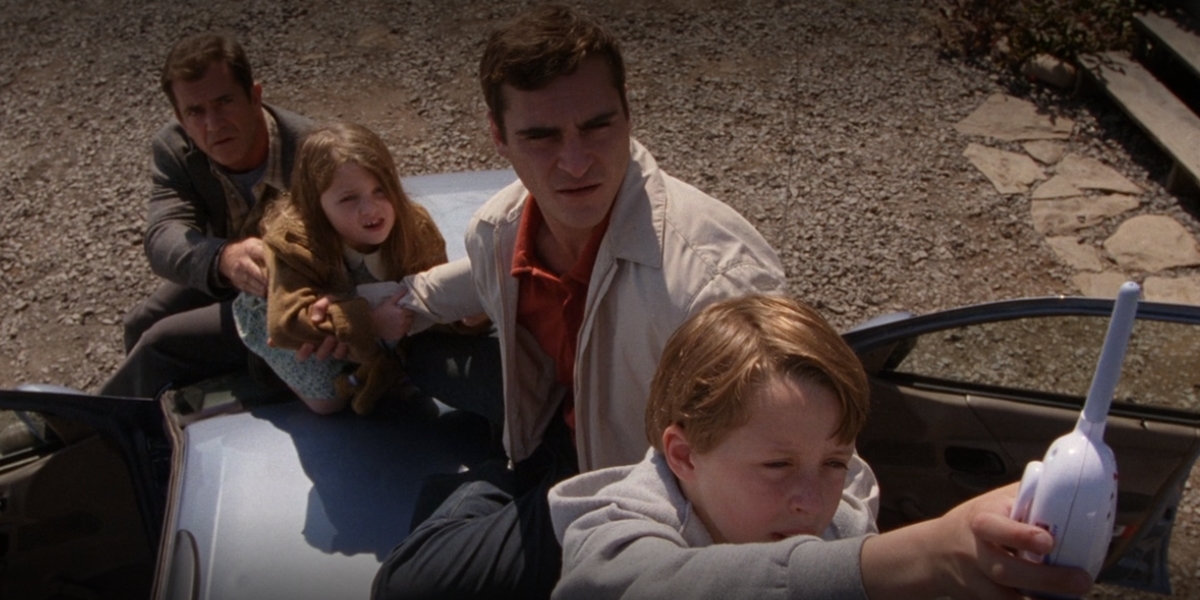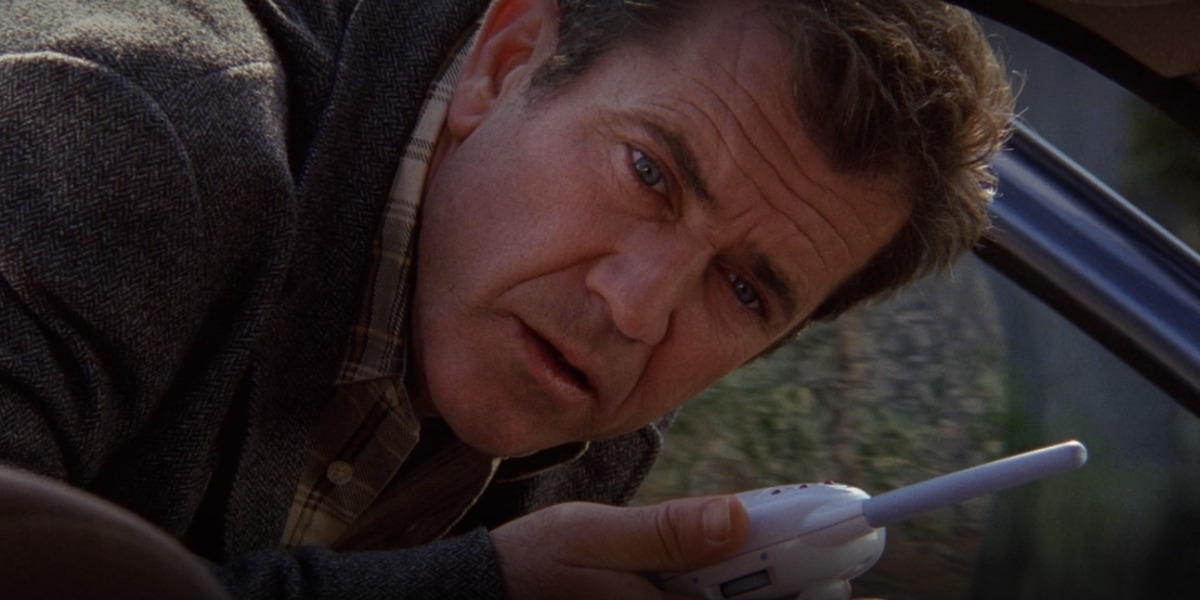Signs it speaks of a man in search of faith and of a family that wanders in search of an answer to his pain. Then there are crop circles and aliens, but they are far less important.
This is how Shyamalan’s best films are: under a cumbersome story made of suspension of breath and disbelief, of curves and U-turns, there is an existential tension. The characters are restless, looking for something that turns out to be an acceptance of what is their own reality.
Agree to to be deadthis was the Sixth Sense. Agree to to be alivethis is Signswho turned 20 this week.
Signs: a global invasion of a family history
Mel Gibson plays Graham Hess, a retired Protestant pastor. he spends his days in Bucks County in Pennsylvania with his brother Merrill (Joaquin Phoenix here adorably rough) and their two sons. He lost his wife in a car accident and this pain silently suffocates a deeply changed home. Only the outline of the dust on the wall where the crucifix was hung (what a picture!) And Graham’s good manners remain as a sign of the past. Ordinary man, no longer a shepherd, he moves in the plastered way of someone who doesn’t know what to do. Unable to hurt, to get angry, he is also stuck in the limbo of mourning. He has abandoned his creed, looks with curiosity at his brother’s down-to-earth ways; he can’t imitate them.
Unknowingly, he is still looking for an explanation for his pain, even though he denies it. He has his eyes open for a sign that gives a reason for what happened. Waiting to wake up from a nightmare, as in the introduction of him in the story: a nightmare that ends with a start catapults him into the frame.
Thus, when the wrong sign occurs before him, the ancient religious promise is rekindled in him. That life has a meaning, that everything is part of a design. Following his muscle memory, he comes back to believe it.
What signs are there in Signs?
This does not say the crop circles that happen to him near the house. Those are not God-sent signals. They are concrete evidence of an impending extraterrestrial invasion. There is a non-human presence, yes, but it is an alien that is probing the ground to settle. Graham and Merrill deal with circumstances in the most humane way possible. That is, acting like idiots (how good Shyamalan is here at not taking his characters seriously). As they do this, another more personal and not at all sci-fi film runs parallel to them. Only he doesn’t notice it. And here lies the great balance of this splendid film.
These two contradictory aspects, which can be found throughout the film, are best represented by a scene. The first contact via radio.
Shocked by the news about the theories of an extraterrestrial invasion, the Hess, who have a crop circle under their house, want to think about something else. They hope it’s just television nonsense. Collective suggestion (what little confidence for a former man of faith). They go to town, they take some time for them to calm their spirits.
However, they briefly meet Ray, the man who unintentionally killed Graham’s wife. Ray is not played by chance by M. Night Shyamalan himself, who does not have great acting skills but it was necessary that he be the one to wear those clothes. Because Ray is the director of this story: he triggered the starting situation. Because of him there is the ghost that haunts the family: the lack of the deceased mother. And it is he who begins the healing process by appearing, re-entering their everyday life while being initially observed from a distance (a fully cinematic process) and finally asking for acceptance.
Back home by car, I’m in the yard. Morgan (Rory Culkin), the eldest son, picks up an unusual signal via a baby monitor that uses a walkie talkie. The empty chatter of adults ends, the car stops, and everyone starts listening.
Aliens, distant mothers, and God: everyone is looking for something
Here Shyamalan plays with the symbology of the situation and with that of the composition of the shot. The film believes that there is a sense in the days, a path traced that leads to a very specific conclusion. To understand this, however, religiously, the characters must stop and listen. A sign, as the title suggests, which could be a warning: “be careful, there are aliens”. Instead it is a spark of faith.
If at first glance it seems that the family tries to pick up the signal to verify or disprove the theories on the existence of an extraterrestrial life, looking at the scene in the light of the ending, we understand that the meaning is twofold.
So Tak Fujimoto’s photography is first composed horizontally, with regular lines that cut the frame in half. Then, after the first sounds, he finds a pushed verticality. The family passes the object on. In order not to lose the signal of the radio device they must keep it firmly pointed upwards. Across the car Graham and Merrill shake hands and look each other in the eye. They are stationary, they cannot move or “let go”. Morgan gets into the car, takes the device followed by his sister Bo.

The Hess thus form a long chain, perhaps in the vague and irrational hope of amplifying the signal. They are all united to point an antenna to the sky, listening to the dialogue between two voices. Without understanding its meaning.
From the earth to the sky, passing through the hands
In search of a solution to the void that left death, Signs tell about this. There is a monster to defeat, as in all fairy tales. There is Shyamalan’s overwhelming spirituality that also affects his characters. In the end, however, the images and movements of the characters manage to keep the film anchored to a very physical and concrete perspective.
In the big final twist, everything is resolved just like in a fulfilled prophecy. The signs collected along Signs they are the foreshadowing of how the four will be saved. The science fiction perspective ends with the defeat of the extraterrestrials incompatible with water. The religious one with the almost ecstatic vision of the woman who, dying, knows for an instant the whole line of the family’s destiny. In a near-death delirium she tells him what to do in detail. Like all prophecies, however, this too can only be understood by living.

But Signs it does not end here, it is not just that. Just as the first contact scene not only has two readings, it has a third. The earthly one. Thus Shyamalan makes the actors move by building precise spatial relationships. First everyone has their own seat in the car. Then they all go out, it’s chaos. Then they jump on top of each other. Finally they all tend upwards. They cling to hope, no matter if it is rational or not.
This is how pain goes according to Shyamalan, and that’s what he’s talking about Signs. Here lies the most complex and engaging emotion, but also difficult to find, of the film. There are those who, like the very human Merrill, need to defeat his black man, the alien who lives with him in the house. Graham for his part embodies the choice of faith, that is, accepting death by finding a reason for it in life. Finally, there are the two children, who are simply without a mother, and feel a little philosophical, very concrete lack. They go on touching each other with their hands, creating a chain for the rest of the family. Feeling safe among the living. Holding them tight, holding them close, while they look away.
You can also follow the BadTaste editorial team on Twitch!
A film in a scene: the three souls of Signs represented in a perfect little scene

